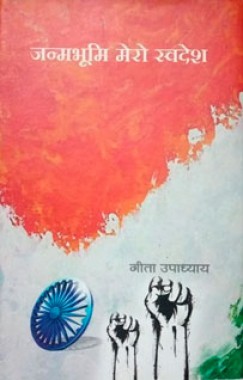




















Wednesday, May 20, 2020 13:00 [IST]
Last Update: Wednesday, May 20, 2020 07:23 [IST]
Anjan Baskota
Name of the Book: Janmabhumi Mero Swadesh
Author: Ms. Gita Upadhyay
Genre: Novel (a social novel in Nepali)
Edition: First in 2013.
Publisher: Anurag Prakashan, Guwahati, Assam, India.
Price: Rs. 250/- (INR).
About the author:
An eminent writer Ms. Gita Upadhyay who fluently writes in the Assamese, Nepali and English language was born on 14th February 1939. Her parents were Bhagirathi Devi and Tankanath Upadhyay. A total number of eleven books in Nepali and thirteen books in the Assamese language have been credited into her account so far. Ms. Upadhyay’s best known books in the Nepali language are- ‘Anne Frankko Diary’ (1972), ‘Ama ma first vaye’ (1998), ‘Mahapurush Sankardev; Jeevan ra karma’ (2003), ‘Rajdarbar ki susare’ (2008), ‘Janmabhumi Mero Swadesh’ (Nepali Novel-2013). Like way her Assamese creations are- ‘Bhanu Bhaktar Ramayan’ (1987), ‘Ma Moi first Holu’ (1997), ‘Muna Madan’ (1998), ‘Nepal Deshar Sadhu’ (2001), ‘Karmabir Dhan Bahadur niz Abhibyaktir Daponat’ (2008) etc. She has been awarded with Sahitya Akademy Translation award (in Nepali) for translation of ‘karengar Ligiri’; a famous Drama by Rupkunwor Jyoti Prasad Agarwala into Nepali language as ‘Rajdarbar ki susare’ and Sahitya Akademy Award for her Novel ‘Janmabhumi Mero Swadesh’ in 2016.
JanmaBhumi Mero Swadesh: a critical analysis
An original history based social novel which has been awarded by the Sahitya Akademy in 2016 is a widely read in Nepali literature. The novel plays a significant role in establishing the contribution of the Nepalese of this region. The story of the novel develops with the story of protagonist Chhabilal Upadhyay. Chhabilal Upadhyay was popularly known as Chhabilal Babu amongst his friend circle and Nepali/Gorkha Gandhi amongst the mass people. Chhabilal; a common man who was born in Majgaon, Behali under Darrang district has played a significant role in the freedom movement of India. The novel depicts the socio-politico history of then Assamese-Nepali society. The then Nepali community people were engaged in agriculture and animal husbandry only. The Nepalese were granted graziers permit by the British govt. to hold cow or buffalo sheds in the forest lands throughout the N.E region. But with the passage of time the British govt. initiated eviction drive in the cow sheds falling under wild life sanctuaries. A large number of Nepali cow keepers had to suffer a lot by the sudden eviction drive. The damage caused by the govt. eviction was unexplainable. The cow or buffalo keepers of Kaziranga, Behali, Batiamari, Gameri, Sootea, Panpur, Bura Chapori etc had lost their only way of livelihood. Chhabilal’s family too was badly affected by the inhuman action of the British govt. They had to lose their animals and cowshed of Kaziranga.
Chhabilal was deeply pained by the inhumane eviction that brutally affected the graziers. This very incident of eviction turned a common boy Chhabilal into a rebellious fellow. He immediately approached for legal action against the govt. Chhabilal moved to Tezpur court to appeal against the illegal eviction drive. He met Chandra Nath Sarmah; an emerging lawyer in the lawyer’s chamber and discussed the very issue with him. C.N.Sarmah who took the matter seriously invited him to his residence. C.N.Sarmah appealed Chhabilal to join Assam Association and to raise the issue in the floor of Assam Association. Chhabilal agreed to his proposal and joined the Assam Association’s Jorhat session. Chhabilal reached close to Juladhar Chaliha, Gopinath Bordoloi, Tarunram Phukan, Omeo Kumar Das, Laxmidhar Sarmah, Siba Prasad Agarwala, Bishnuram Medhi along with C.N.Sarmah. In the meeting of Assam Association, the issue of graziers and illegal eviction was discussed vividly. Chhabilal had to preside over the last public meeting of Assam Association in which Assam Association was renamed as Asam Pradesh Congress Committee. A simple boy from a less known village got the opportunity to make a public address being the chairman of the open session. Being in the chair he had raised the burning issue of graziers. Like way the session consisted an inquiry committee and took a proposal to look into the matter.
As per the directives from the Congress committee, the Assam Congress Committee too started a mission of membership drive and collection for Tilak Swaraj Fund. Chhabilal played a pivotal role in creating awareness among the people about the freedom movement and appeal the general people to join the party.
The protagonist Chhabilal became a local leader of Congress Committee who had to undergo police custody many a time. But he was unstoppable and worked for the Congress party till attainment of freedom. Chhabilal did not confine himself in the Nepali community only moreover he had organized the people of Assamese, Adhibasi (Tea Tribe), Mising community also. He played the role of torch bearer in the locality with the help of his mates like Bogiram Hazarika, Paniram Das, Banamali Hazarika, Bhim Bahadur, Tikaram Upadhyay, Laxmi Sarmah, Bhimlal etc.
‘Janmabhumi Mero Swadesh’ mainly deals with the issues and problems of pre-independence India. The issues of graziers, Nepali cultivators, Kaziranga eviction etc have been raised and discussed minutely. How the people of Mising, Assamese and Nepali graziers community suffered by the eviction have been highlighted throughout. It focuses the ray on how the Nepali Community has contributed towards socio-economic development of the state and the nation at a large. How the common Nepali people were associated in non cooperation movement, quit India movement as per the appeal made by Mahatma Gandhi has been discussed vividly.
Chhabilal; an ideal character of the novel and a real life hero not only engaged himself in the freedom movement of India but also played a distinguishing role in establishing schools in various villages of greater Behali area. Chhabilal became an ideal figure for the Nepali community.
Every pages of the novel seem like the diary pages of Babu Chhabilal and remind the readers about his thinking capacity, his will power, his ideology, dream for serving his people and community etc. His social contact, family life, his social acceptability as a leader etc have been woven nicely.
Novelist Ms. Upadhyay does not forget to describe the natural beauty of the soil here. The mighty Brahmaputtra, the beauty of Kaziranga, mutual co-ordination amongst the people of different race and community have been placed and explained marginally.
The beautiful landscape of the region as well as mental state of Chhabilal has been well depicted. The language of the novel is colloquial. Many Assamese-Nepali words have been used in the novel which added an element of beauty to this novel.
Conclusion:
In my opinion, it is one of the finest novels. The history based social novel states about the history and settlement about the Nepalese of this region as well as their valuable contribution towards freedom movement of India as well.
(email:anjanbaskota11@gmail.com)
